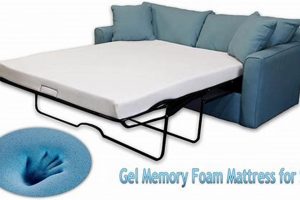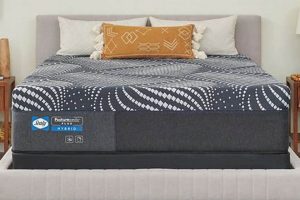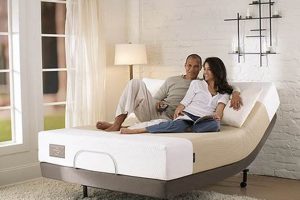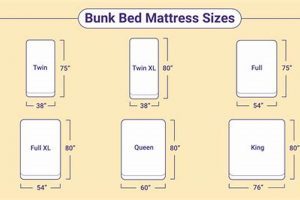An essential component of infant and toddler sleep environments, the core bedding provides a safe and supportive surface for developing bodies. It is specifically designed to fit within the confines of a smaller bed frame, offering a comfortable and secure space for rest. For instance, a parent might select a firm, breathable option to ensure their child’s proper spinal alignment and reduce the risk of overheating during sleep.
The selection of appropriate bedding contributes significantly to a child’s sleep quality and overall well-being. A properly chosen sleeping surface can promote healthy posture, reduce pressure points, and minimize sleep disturbances. Historically, the evolution of these products has focused on enhanced safety features, improved hygiene, and the use of non-toxic materials to safeguard infant health. Its use is vital in providing secure and comfortable sleep.
Subsequent discussion will explore various construction materials, safety certifications, size considerations, and cleaning recommendations relevant to selecting the optimal sleeping surface for a young child’s bed. Factors such as firmness levels and breathability will also be examined to aid in making an informed purchase decision.
Guidance on Selecting a Sleeping Surface for a Child’s Bed
The following recommendations aim to provide a framework for choosing the most suitable resting surface, considering factors that influence safety, comfort, and durability.
Tip 1: Prioritize Safety Certifications: Ensure the chosen product meets established safety standards, such as those from JPMA or CertiPUR-US, to minimize exposure to harmful chemicals and ensure structural integrity.
Tip 2: Evaluate Firmness: A firm surface is recommended to reduce the risk of suffocation and promote proper spinal development. Avoid excessively soft options that could contour too deeply.
Tip 3: Consider Material Composition: Opt for breathable materials like cotton or wool to regulate temperature and minimize overheating. Hypoallergenic options can be beneficial for children with sensitivities.
Tip 4: Measure Dimensions Accurately: Verify that the purchased product fits snugly within the bed frame to prevent gaps that could pose a safety hazard. Precise measurements are crucial for a secure fit.
Tip 5: Assess Cleanability: Look for options with removable, washable covers to facilitate easy cleaning and maintain a hygienic sleep environment. Stain-resistant fabrics are also advantageous.
Tip 6: Check Warranty and Reviews: Research the manufacturer’s warranty policy and review customer feedback to gauge the product’s longevity and performance over time. Real-world experiences can provide valuable insights.
Tip 7: Consider a Waterproof Liner: A waterproof liner beneath the fitted sheet protects the core from moisture damage and extends its lifespan. Ensure the liner is also breathable to prevent overheating.
Adhering to these guidelines can aid in selecting a sleeping surface that prioritizes safety, comfort, and longevity, contributing to a child’s well-being and restful sleep.
The following sections will address common concerns regarding care and maintenance practices for this essential item.
1. Firmness
Firmness is a critical characteristic in the context of a sleeping surface for an infant or toddler, influencing safety, spinal development, and overall sleep quality. This parameter dictates the degree to which the surface resists compression under weight, directly impacting the support provided to the child’s body.
- Suffocation Risk Mitigation
A firm surface minimizes the risk of suffocation by preventing the child from sinking deeply into the bedding, which could obstruct airways. Softer surfaces can conform around the face, creating a hazardous environment. Regulatory guidelines often specify minimum firmness levels to mitigate this risk.
- Spinal Alignment and Development
Adequate firmness supports proper spinal alignment during sleep, promoting healthy musculoskeletal development. An overly soft surface can lead to spinal curvature and discomfort. A consistently firm surface encourages a neutral spine position.
- Reduced Pressure Points
While firmness is essential, a balance is necessary to prevent excessive pressure on bony prominences. The ideal firmness level provides adequate support without creating concentrated pressure points that could disrupt sleep. This balance contributes to comfort and reduces the likelihood of restlessness.
- Durability and Longevity
A firm sleeping surface typically maintains its shape and supportiveness over a longer period compared to softer alternatives. Reduced compression over time contributes to enhanced durability and extends the lifespan. This directly impacts the product’s value proposition.
The selection of a bedding material with appropriate firmness constitutes a vital aspect of ensuring a secure and supportive sleep environment for young children. Regulatory bodies and pediatric health professionals consistently emphasize the importance of this characteristic, influencing manufacturing standards and consumer guidance.
2. Dimensions
The correlation between dimensions and a bedding insert designed for a childs bed frame is foundational to safety and functionality. Accurate dimensions are not merely a specification but a critical prerequisite ensuring the product fits appropriately within the cot structure, preventing hazardous gaps. The dimensional accuracy directly influences the effectiveness of the designed sleep environment, as disparities can compromise safety standards and intended use. For example, a product that is too small creates spaces where a child could become trapped, while an oversized version may not properly fit, leading to instability. This precise relationship underscores the importance of adhering to standardized size specifications.
Consider a scenario where a parent purchases bedding advertised as conforming to a standard European cot size (60cm x 120cm). If the actual dimensions deviate by even a few centimeters, it can result in uneven support and potential safety hazards. The practical implications extend to the manufacturing process, where stringent quality control measures are necessary to maintain dimensional consistency. Retailers and regulatory bodies rely on these standards to ensure that products available to consumers meet established safety requirements. Failure to comply with these standards can result in product recalls and legal liabilities. Furthermore, the selection of appropriate bedding involves consulting the cot manufacturer’s specifications to guarantee compatibility.
In summary, the dimensional aspect of a sleeping surface represents a primary safety concern. Its precision and adherence to industry standards a
re crucial for preventing potential hazards, maximizing usability, and ensuring a secure sleep environment for infants and toddlers. Discrepancies in dimensions present considerable risks, emphasizing the need for careful measurement and conformity checks. This fundamental attribute links directly to the overall well-being and safety of the child, reaffirming its significance in product design and consumer selection.
3. Breathability
Breathability represents a critical performance parameter in cot bed sleeping surfaces, impacting thermoregulation, moisture management, and overall safety. The capacity of a sleeping surface to allow air circulation plays a pivotal role in maintaining a comfortable and secure sleep environment for infants and toddlers.
- Thermoregulation
Effective breathability facilitates the dissipation of body heat, preventing overheating and reducing the risk of heat-related discomfort. Infants possess limited thermoregulatory capabilities, rendering them particularly vulnerable to overheating. A breathable surface allows for continuous air exchange, promoting a stable body temperature and reducing the risk of sudden infant death syndrome (SIDS) associated with excessive warmth.
- Moisture Management
Breathable sleeping surfaces mitigate moisture accumulation by wicking away perspiration and other fluids. This reduces the likelihood of bacterial growth and skin irritation. The presence of moisture can create a conducive environment for microbial proliferation, potentially leading to skin infections or allergic reactions. Efficient moisture management ensures a hygienic and comfortable sleeping environment.
- Material Composition Influence
The breathability of a sleeping surface is directly influenced by its constituent materials. Natural fibers such as cotton, wool, and bamboo exhibit superior breathability compared to synthetic alternatives like polyurethane foam. The fiber structure and weave pattern contribute significantly to air permeability. Open-cell foam structures also enhance breathability by allowing for greater airflow.
- Design and Construction Techniques
Design features such as ventilation channels, perforated layers, and breathable covers further enhance air circulation. These design elements work synergistically to promote airflow and minimize heat retention. Construction techniques that prioritize breathability contribute to the creation of a safer and more comfortable sleep environment.
The selection of a cot bed sleeping surface that prioritizes breathability is essential for promoting infant well-being. By facilitating thermoregulation, managing moisture, and minimizing the risk of overheating, a breathable surface contributes significantly to a safe and comfortable sleep environment. Considerations relating to material composition and design characteristics should guide the selection process to optimize breathability performance.
4. Materials
The selection of materials constitutes a foundational consideration in the context of cot bed sleeping surfaces. Material properties directly influence safety, comfort, durability, and overall suitability for infant and toddler use, necessitating careful evaluation.
- Foam Composition
Foam, often polyurethane or memory foam, provides core support and cushioning. Density and composition affect firmness, breathability, and chemical off-gassing. Higher density foams generally offer greater support and durability, while open-cell structures enhance airflow. Certifications like CertiPUR-US ensure minimal VOC emissions. Flame retardants, if present, should adhere to stringent safety standards.
- Fiber Fillings
Natural fibers, such as cotton, wool, and bamboo, offer enhanced breathability and moisture-wicking properties. Cotton is hypoallergenic and relatively inexpensive, while wool provides excellent temperature regulation and natural fire resistance. Bamboo is sustainable and possesses antimicrobial characteristics. Synthetic fiber fills, like polyester, are often used for their affordability and hypoallergenic properties but may offer less breathability.
- Cover Fabrics
The outer cover material directly contacts the child’s skin, necessitating soft, breathable, and hypoallergenic options. Organic cotton, bamboo, and Tencel are commonly used due to their gentle feel and moisture-wicking abilities. Waterproof or water-resistant coatings, typically polyurethane laminates, protect the core from spills and stains but can reduce breathability. Removable, washable covers are essential for maintaining hygiene.
- Flame Retardants
Regulations often mandate flame retardant treatments. Historically, PBDEs were used, but concerns about their toxicity led to their phase-out. Safer alternatives, such as boron-based compounds or inherently flame-resistant fibers like wool, are now preferred. Full disclosure of flame retardant chemicals is crucial for informed consumer choice.
The interplay between these materials directly influences the safety and comfort characteristics of the chosen sleeping surface. Informed material selection represents a critical aspect of ensuring a secure and supportive sleep environment, influencing product longevity and contributing to the overall well-being of the child.
5. Certifications
The presence of relevant certifications on a bedding insert for a cot bed serves as a critical indicator of product safety and adherence to established industry standards. These certifications provide assurance that the product has undergone rigorous testing and meets specific criteria regarding material composition, flammability, and chemical emissions.
- CertiPUR-US Certification
This certification verifies that the foam used in the construction of the bedding has been independently tested and certified to meet specific standards for content, emissions, and durability. It ensures that the foam is made without ozone depleters, PBDE flame retardants, mercury, lead, and other heavy metals. It also confirms low VOC (Volatile Organic Compound) emissions for indoor air quality. Consumers can rely on this certification to minimize potential exposure to harmful chemicals.
- GREENGUARD Gold Certification
The GREENGUARD Gold Certification signifies that the sleeping surface has been tested for chemical emissions, including VOCs, to ensure it meets stringent indoor air quality standards. It is particularly relevant for products intended for use in environments occupied by sensitive individuals, such as children. This certification confirms that the product contributes to healthier indoor air quality, minimizing potential health risks associated with chemical exposure.
- OEKO-TEX Standard 100 Certification
This certification ensures that all components of the bedding, including fabrics, threads, and fillings, have been tested for harmful substances and meet strict human-ecological requirements. It guarantees that the product is free from allergenic dyes, pesticides, and heavy metals, making it sa
fer for direct contact with a child’s skin. This certification is valuable for parents seeking to minimize their child’s exposure to potentially harmful chemicals in textile products. - JPMA Certification
The Juvenile Products Manufacturers Association (JPMA) certification indicates that the sleeping surface meets or exceeds ASTM safety standards for juvenile products. This certification program involves independent laboratory testing to verify compliance with safety requirements related to structural integrity, flammability, and chemical content. It provides assurance that the product has been designed and manufactured to minimize potential hazards for infants and toddlers.
In conclusion, the presence of certifications on a cot bed sleeping surface is a significant factor in assessing its safety and suitability. These certifications offer independent verification that the product meets established industry standards and minimizes potential risks associated with chemical exposure, flammability, and structural integrity. Consumers are advised to prioritize products with relevant certifications to ensure a safer sleep environment for their children. The selection of certified products aids in promoting the well-being and safety of infants and toddlers during their crucial developmental stages.
6. Cleanability
Cleanability is a paramount attribute of a sleeping surface intended for a cot bed, directly impacting hygiene, health, and the product’s longevity. The infant and toddler demographic is inherently prone to spills, accidents, and regurgitation. The presence of bodily fluids and other contaminants creates a breeding ground for bacteria, mold, and allergens. Inadequate cleanability precipitates unsanitary conditions, elevating the risk of skin irritations, respiratory issues, and other health complications. Failure to maintain hygiene compromises the integrity of the sleeping environment.
The practical significance of this principle manifests in several design and material choices. Removable, washable covers enable thorough sanitation, eliminating embedded contaminants. Waterproof or water-resistant surfaces, frequently achieved through laminates, prevent liquid penetration, safeguarding the inner core from irreversible damage. Antimicrobial treatments, while subject to scrutiny, seek to inhibit microbial growth. Consider a scenario where a baby experiences nighttime reflux. If the bedding lacks adequate cleanability features, the acidic contents can permeate the material, fostering bacterial growth and emitting unpleasant odors. This compromises the sleeping surface’s hygiene, necessitating frequent replacement. Furthermore, the selection of stain-resistant fabrics simplifies cleaning procedures, mitigating the visual impact of minor accidents.
In summary, cleanability functions as a vital component in maintaining a safe, hygienic, and durable sleeping environment for infants and toddlers. Its impact extends beyond mere aesthetics, directly influencing health and product lifespan. The integration of features such as removable covers, waterproof barriers, and stain-resistant materials are crucial design considerations. Prioritizing this attribute represents a proactive approach to minimizing health risks and maximizing the longevity of a cot bed sleeping surface. Inadequate attention to cleanliness undermines both the product’s value and the well-being of its intended user.
Frequently Asked Questions Regarding Cot Bed Sleeping Surfaces
The following addresses common inquiries concerning the selection, use, and maintenance of infant and toddler bedding inserts to provide clarity and promote informed decision-making.
Question 1: Is a firm sleeping surface truly necessary for an infant?
A firm surface is non-negotiable for infant sleep safety. This firmness minimizes the risk of suffocation by preventing the infant from sinking into the bedding, which can obstruct airways. Soft surfaces increase the likelihood of SIDS. Medical professionals universally recommend a firm sleeping surface.
Question 2: How frequently should a bedding insert be replaced?
Replacement frequency hinges on several factors, including material quality, usage intensity, and hygiene maintenance. Signs of wear, such as sagging, tears, or persistent odors, necessitate immediate replacement. As a general guideline, a new bedding insert is advisable for each new child.
Question 3: Are waterproof liners essential, and do they compromise breathability?
Waterproof liners provide a barrier against spills and accidents, safeguarding the inner core from damage. Breathable waterproof liners, crafted from materials like polyurethane laminates, mitigate moisture accumulation while allowing air circulation. Selecting a breathable option minimizes the risk of overheating. They are crucial for maintaining hygienic conditions and extending the lifespan.
Question 4: What cleaning practices are recommended for soiled bedding inserts?
Immediate cleaning of spills and accidents prevents staining and microbial growth. Removable covers should be laundered according to the manufacturer’s instructions. Spot cleaning with a mild detergent is suitable for minor stains. Thorough drying is essential to prevent mold formation.
Question 5: Are there specific dimensions to ensure a safe and secure fit within the cot bed frame?
Precise dimensional accuracy is paramount. The bedding insert should fit snugly within the cot frame, leaving no gaps where a child could become entrapped. Consult the cot manufacturer’s specifications for recommended dimensions. Discrepancies, even minor ones, elevate the risk of injury.
Question 6: Do certifications genuinely guarantee product safety?
Certifications, such as CertiPUR-US and GREENGUARD Gold, provide independent verification of product safety and compliance with industry standards. These certifications involve rigorous testing for harmful chemicals and emissions. While not foolproof, they offer a reasonable level of assurance regarding product safety and quality.
The preceding addresses core concerns pertaining to sleeping surfaces, emphasizing the imperative of informed selection and diligent maintenance. Prioritizing safety and hygiene promotes a secure and healthful sleep environment.
The succeeding section will explore emerging trends and innovations within the realm of infant and toddler bedding.
Conclusion
This exploration of the mattress for cot bed underscores its critical role in infant and toddler sleep environments. The presented information highlights the significance of firmness, dimensions, breathability, materials, certifications, and cleanability in selecting an appropriate product. Prioritizing these factors is essential for mitigating safety risks and promoting optimal sleep quality.
Continued research and adherence to evolving safety standards remain vital in ensuring the well-being of young children. A commitment to informed decision-making regarding sleeping surfaces contributes significantly to fostering a secure and healthy developmental environment.



![Best Queen Adjustable Bed & Mattress [Guide & Reviews] Organic & Natural Mattress Buyer’s Guide: Non-Toxic Sleep Solutions Best Queen Adjustable Bed & Mattress [Guide & Reviews] | Organic & Natural Mattress Buyer’s Guide: Non-Toxic Sleep Solutions](https://mattressworldpa.com/wp-content/uploads/2025/07/th-7128-300x200.jpg)



